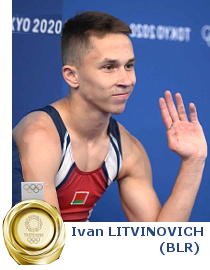TOKYO 2020 - TRAMPOLINE GYMNASTICS
 |
|
<... Gold for Belarus again! |
For the sixth time since the Olympic premiere in 2000 in Sydney, TRAMPOLINE GYMNASTICS (men & women) is part of the Olympic program, also now at the 32nd Olympic Summer Games in Tokyo. In the Olympic men's final the Belarusian top qualifier Ivan LITVINOVICH has edged Chinese veteran DONG Dong to win gold. Young "Kiwi" Dylan SCHMIDT from Auckland/New Zealand, who placed 7th at the Olympic Games in Rio, won now a surprise bronze medal, in front of the fourth placed 2016 Olympic Champion Vladislau Hancharou less than a tenth of a point...!
 ZHU Xueying (right) from China soared to new heights to win gold in the women’s trampoline gymnastics for the People’s Republic of China to the second time after HE, Wenna in Beijing 2008. In a highly competitive final, the 23-year-old executed a series of superb twists, bounces and somersaults to finish top of the leaderboard with 56.635 points.
ZHU Xueying (right) from China soared to new heights to win gold in the women’s trampoline gymnastics for the People’s Republic of China to the second time after HE, Wenna in Beijing 2008. In a highly competitive final, the 23-year-old executed a series of superb twists, bounces and somersaults to finish top of the leaderboard with 56.635 points.
The brilliant routine denied competition favourite, Canada’s Rosannagh MacLennan, her third Olympic gold in the event. The 32-year-old finished just outside the medals in fourth on 55.460.
.
 The Canadian gymnast had been in the bronze medal position and had an agonising wait until Zhu, a former Youth Olympics champion, who was the last competitor, performed her routine. Her Chinese teammate, LIU Lingling (26; left) won silver with a score of 56.350 at the Ariake Gymnastics Centre on 30 July. Both Chinese athletes had qualified first and second out of a field of 16 going into the final. It was the first time one country has won gold and silver in the women's trampoline gymnastics at an Olympics.
The Canadian gymnast had been in the bronze medal position and had an agonising wait until Zhu, a former Youth Olympics champion, who was the last competitor, performed her routine. Her Chinese teammate, LIU Lingling (26; left) won silver with a score of 56.350 at the Ariake Gymnastics Centre on 30 July. Both Chinese athletes had qualified first and second out of a field of 16 going into the final. It was the first time one country has won gold and silver in the women's trampoline gymnastics at an Olympics.
The bronze went to a delighted Great Britain’s Bryony PAGE (30) who won silver in Rio 2016 with 55.735. The big upset of the event was world number three, Japan’s MORI Hikaru, 22, did not appear in the final after she failed to complete her second routine in the qualifying round. Her teammate, UYAMA Megu, came fifth on 54.655.
.
♦ The men's competition finished the sixth Olympic Trampoline decisions in history, Saturday July 31 ...:
 |
♦♦MEN's TRAMPOLINE GYMNASTICS (Saturday, July 31)
Chinese silver medalist DONG, Dong looked set to collect his fourth Olympic medal - and second gold - with Ivan LITVINOVICH from Belarus bouncing perilously close to the edge of the mat during his routine. But Litvinovich, the top qualifier, benefited from his superior difficulty and flight time to score 61.715 and just pip Dong's 61.235. Dong, 32, previously won gold in London, silver in Rio and bronze in Beijing back in 2008.
* Schmidt’s bronze an Olympic first for New Zealand
Seventh at Rio 2016, Schmidt sailed through his second appearance at the Games. The 24-year-old showed excellent form and consistency to claim bronze with 60.675, another first for his country seven years after his upset victory at the 2014 Youth Olympic Games. "Honestly, I still struggle to believe it. I keep putting my hands on [the medal],” he said. “It's been bloody stressful to get here, to perform and compete. But it's done now, and I am on the podium. It's great.” "To make history for New Zealand being their first ever medallists in trampoline gymnastics is amazing. I'm speechless, I knew I was capable of getting here and everything has just paid off."
♦ MEN's F I N A L R E S U L T S
 LITVINOVICH, Ivan (BLR) - 61,715
LITVINOVICH, Ivan (BLR) - 61,715 DONG, Dong (CHN) - 61,235
DONG, Dong (CHN) - 61,235 SCHMIDT, Dylan (NZL) - 60,675
SCHMIDT, Dylan (NZL) - 60,6754. HANCHAROU, Vladislav (BLR) - 60,565
5. USHAKOV, Dmitri (ROC) - 59,600
6. YUDIN, Andrey (ROC) - 58,235
7. KISHI, Daiki (JPN) - 57,815
8. CLARKE, Dominic (AUS) - 24, 955
►► Detailed Results
>> Qualification Results
* Defending Olympic champion Belarusian Uladzislau Hancharou finished fourth.
China's Gao Lei, winner of the last four world titles, did not even make it to the finals after crashing onto the mat. Behind Hancharau the both Russian athletes Dmitri Ushakov and Andrei Yudin ranked on 5th resp. 6th place.
Australia's Dominic Clarke (24) had an unhappy Olympic final. Making his Olympic debut Clarke had the fourth-best score in qualification but bounced out mid-routine in the final to fall to the bottom of the field and advanced to the eight-man final with a combined total of 111.680, scoring 52.130 in his first outing and cracking a wide smile after nailing a 59.550 in his second routine.
++++++++++++++++++++++++++++++++++++++++++++
* FIG PREVIEW:
Rio 2016 Trampoline champion Uladzislau Hancharou (BLR) has waited five years for another chance at Olympic glory. Dong Dong (CHN) is trying to extend his own Olympic record. After bronze in 2016, Gao Lei (CHN) is taking a second shot at gold. And Ivan Litvinovich (BLR), second at the 2019 World Championships in Tokyo, hopes to one up himself in his return to the Ariake Gymnastics Centre.
Their stories converge Saturday, when the Tokyo 2020 Olympic champion in men’s Trampoline will be decided. This 16-person field does not lack strong contenders.
The alpha gymnast of his sport for the past five years, Gao has upstaged all challengers at the past four World Championships. With gold in 2012, silver in 2016 and bronze in 2008, Dong is the only gymnast to have collected a full set of Olympic colours, and a fourth medal would gild his legacy even further.
Hancharou, who upset Gao and Dong to become the first non-Chinese Olympic champion since 2004, is back for more, while Litvinovich, just 20, is exactly where Hancharou was five years ago: a talented reigning World silver medallist, looking to play spoiler.
Part of the Olympic programme since 2000, Trampoline is the youngest Gymnastics discipline at the Games, and no nation has been more successful on the Olympic stage than the People’s Republic of China, which has won 11 of the 30 Olympic medals presented in the discipline, more than any other nation. Three of those 11 belong to Dong.
* How it will play out:
Trampoline gymnasts must perform each of the 10 elements in their routines without stopping or taking extra bounces between skills. If they do, or if they “crash out” onto the mats around the trampoline, the routine is over and they do not get a second chance.
Like in Artistic & Rhythmic Gymnastics, Trampoline gymnasts are judged on the difficulty of their routines and how well their elements are executed, but that is not all. Also taken into account is how centered they are on the trampoline as they land each skill (known as horizontal displacement) and how much time they spend in the air (time of flight), which is measured by a special device under the apparatus.
Gymnasts will perform two exercises in the qualifying round. The first routine is simpler, with special requirements designed to show judges that the gymnast has mastered the basics. The gymnast’s maximum potential is unleashed during the high-flying second routine, known as the voluntary exercise, where daring and difficulty plays a much larger role. The top eight following these two exercises advance to the final, where gymnasts perform only their voluntary exercise. Scores from the preliminary do not carry over.
* Look out for:
The incredible vertical flight gymnasts attain above the trampoline. A trampolinist can bounce up to eight meters in the air, the height of a three story building.
+++++++++++++++++++++++
.
♦♦ WOMEN's TRAMPOLIN GYMNASTICS (Friday, July 30)
♦ FINAL R E S U L T S
 ZHU, Xueying (CHN) - 56,635
ZHU, Xueying (CHN) - 56,635
 LIU, Lingling (CHN) - 56,350
LIU, Lingling (CHN) - 56,350
 PAGE, Bryony (GBR) - 55,735
PAGE, Bryony (GBR) - 55,735
4. MACLENNAN, Rosannagh (CAN) - 55,460
5. UYAMA, Megu (JPN) - 54,655
6. AHSINGER, Nicole (USA) - 54,350
7. KOCHESOK, Susana (ROC) - 54,290
8. NAVARRO, LOZA, Dafne (MEX) - 48,345
►► Detailed Results
>> Qualification Results
* FIG REPORT --:
A golden day for Zhu, and sterling silver for Liu
The Chinese are renowned for their success in Trampoline, accounting for nearly half of the 33 Olympic medals given out since the sport became an Olympic discipline in 2000. Yet despite its nation’s powerhouse status, before Friday its only women’s title had come from He Wenna in 2008.
Tokyo 2020 is the first Olympic Games for both Zhu, a 23-year-old from Beijing who took gold at the 2014 Youth Olympic Games, and Liu, who introduced herself by winning an individual World title the same year. Both controlled their destinies from the outset of the two-routine qualification round that narrowed the field down to eight finalists. Liu qualified to the final in first place, though only 0.170 in front of Zhu, with Page more than half a point behind.
The standings meant Zhu and Liu were the final competitors to perform in the final, where qualification scores did not carry over. Zhu went first of the two and hit for 56.365, while Liu cranked up her difficulty in her attempt to top Zhu for the gold. Though Liu delivered an excellent final performance, 56.350 was only good enough for silver. “I am delighted to have won this gold medal,” said Zhu, Xueying. "I put in a lot of effort to reach the podium. With the Olympic Games Tokyo 2020 being postponed for a year, I had more time to work to prepare and I made an effort to work on the things I wanted to improve. I am very happy with how I did.”
LIU, Lingling, a native of Fuzhou, missed out on Rio 2016 and overcame a debilitating injury to compete in Tokyo. This Games was her now-or-never moment: at 26, she is unsure how many more chances she would have had. “I am almost at a retiring stage, so this is a great milestone for me,” Liu said. “I have been working really hard for this since the age of six. Winning an Olympic medal has always been my dream and taking the silver is amazing.”
Consistent Page books her second Olympic medal
Injuries kept Bryony Page too out of competition for two years following Rio 2016, but Britain’s first Olympic medallist in Trampoline never gave up. Her perseverance paid off Friday, where she delivered crisp and consistent routines, scoring 55.735 to edge MacLennan for bronze by 0.275. “I’m really happy to have made podium for the second time,” the 30-year-old Page said. “It feels really, really special, and I just want to thank everyone who’s helped me to get here.” With this result, Page becomes the fifth female gymnast to earn multiple Olympic medals in Trampoline, in company with MacLennan, He, Huang Shanshan (CHN) and Karen Cockburn (CAN).
Fourth place just fine with injured MacLennan
A severe ankle injury sustained two months ago meant MacLennan was off the razor sharp form she displayed in London and Rio, dashing her hopes of a third consecutive Olympic title at her fourth Olympic Games. In the end, the 32-years-old was happy to even finish fourth. Getting to the Games was “a struggle,” she said, but it also lifted the pressure she might have otherwise felt as the defending champion. "Obviously I am a little sad that I didn't get to stand on the podium,” MacLennan said, “but there were many great athletes in this final who performed very well, and I am happy for them. "If you would have told the nine-year-old me that I would get to compete in four Olympic Games I would have been very excited. This is just beyond my wildest dreams and I am very proud of it."
.
♦ P R E V I E W:
* The qualification on Friday (July 30th) & Saturday (July 31) was carried out with two ten-part exercises, which in the past were called compulsory and freestyle.
The eight best athletes in the preliminary competition qualify for the Olympic Finals on the afternoon of the same day.
* The competitions start at 1.00 pm local time (Friday: women / Saturday men), and the final fights are already scheduled for almost 2 hours later (2.45 pm.).
-----------------------------------------------------------------
* Women's competition:
Is there more history in store for Rosannagh MacLennan (CAN) as two intense days of Trampoline Gymnastics begins at Tokyo 2020?
The women’s Trampoline medallists will be determined Friday from a 16-person field, with the men’s competition following on Saturday, also culled from a field of 16.
MacLennan, already the only repeat Olympic champion in the history of the sport, is aiming to execute a triple in Tokyo and become the only Trampoline gymnast to claim three Olympic golds. With a medal of any colour, she would join compatriot Karen Cockburn (CAN) as the only woman to land on the Olympic podium three times. MacLennan’s title five years ago at Rio 2016 came after a roller coaster few years in which the 32-year-old battled injuries, and the road to Tokyo has not been altogether smooth either. MacLennan broke her ankle at a World Cup event in 2019, but went on to win bronze at the World Championships in Ariake Gymnastics Centre in Tokyo later that year. The pandemic delay gave her time to hone her focus for her fourth Olympic Games, she said.
The medal contenders are an accomplished group. In addition to MacLennan, 2016 Olympic silver medallist Bryony Page (GBR), 2019 World champion Mori Hikaru (JPN), 2014 World champion Liu Lingling (CHN), and 2014 Youth Olympic Games champion Zhu Xueying (CHN) are among those with a shot at the top three.
Part of the Olympic programme since 2000, Trampoline is the youngest Gymnastics discipline at the Games, and no nation has been more successful on the Olympic stage than the People’s Republic of China, which has won 11 of the 30 Olympic medals ever presented in the discipline, more than any other nation.
→ How it will play out: Gymnasts perform two exercises in the morning qualifying round, trying to be among the top eight that will advance to the afternoon’s medal round. The first routine in qualifying is simpler, with special requirements designed to show judges that the gymnast has mastered the basics, and contains only four high difficulty elements. The gymnast’s maximum potential is unleashed during the second routine, known as the voluntary exercise.
Gymnasts perform their voluntary exercise again in the final to determine the podiums. Scores from the preliminary do not carry over to the final.
* Competition Coverage: ...
...
* At this point we refer to different > LIVESTREAM versions in your countries on the day of the event and GYMmedia will provide up-to-date information via a short report / presentation of results.
- the Editors















